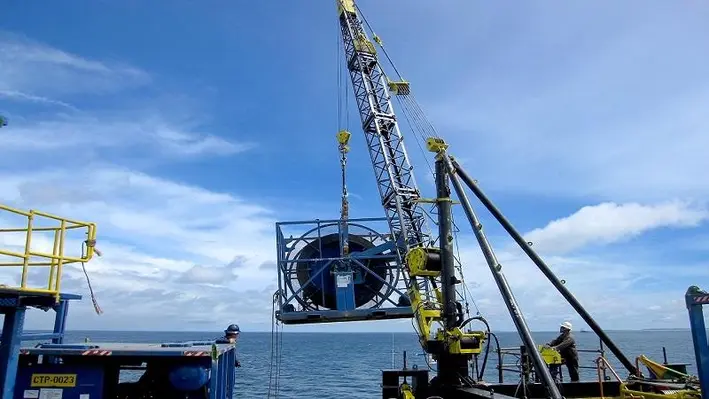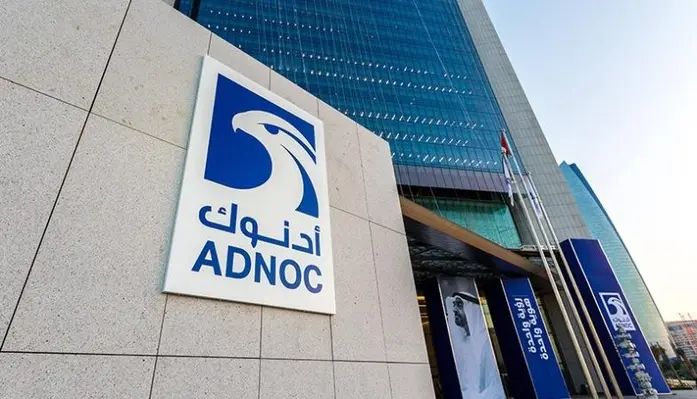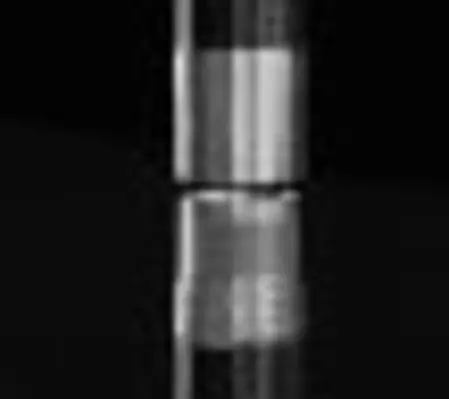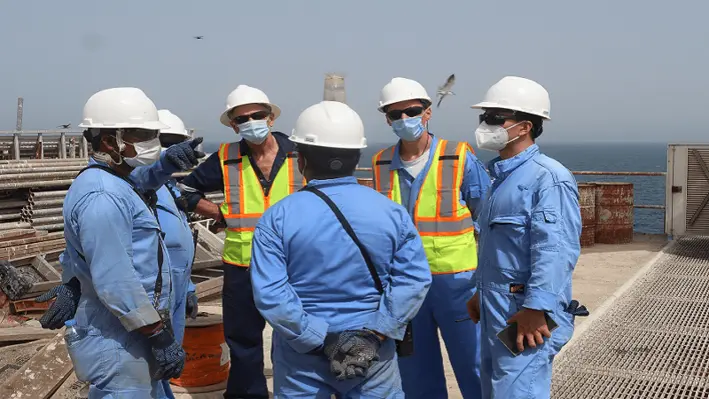

TGT Diagnostics, a through-barrier diagnostics company for energy production and storage, has launched its latest acoustic platform, ChorusX, a new diagnostic resource specifically designed to locate and characterise flow in oil and gas wells.
This all-new acoustic array platform enables energy companies to find and map fluid flow throughout the well-reservoir system with greater ease and precision, helping them to keep wells safe, clean, and productive.
Ken Feather, TGT’s Chief Marketing Officer, commented, “Understanding flow dynamics in the well system is the key to unlocking better well and reservoir performance, and acoustic techniques have become an indispensable means of achieving that goal. ChorusX is the result of two decades of intensive research, innovation, and extensive field experience in applying the power of sound to flow diagnostics in thousands of wells. Eight high-definition array sensors, extreme dynamic range recording and a unique phase analysis engine work in concert to deliver uncompromising levels of clarity, precision, and certainty to analysts and well operators.”
At the heart of ChorusX is a compact array of eight nano-synchronised sensors that record high-resolution flow sounds across an extreme dynamic range of intensities and frequencies. A unique phase analysis workflow combines specialised acoustic field modelling with a sophisticated waveform-matching algorithm. This combination delivers an important new dimension to acoustics and flow diagnosis – radial distance. In combination, these advances underpin four new complementary answer products that enable TGT analysts to easily and accurately locate and map flow throughout the well system.
Ken added, “ChorusX has been redesigned from the ground up to excel in three important areas: extending spatial and audible reach to record the lightest, quietest, and furthest flows; recognising different types of flows; and pinpointing flow sources with unmatched accuracy in depth, and radially. Flow events are displayed more clearly in high definition, enabling operators to plan actions with greater confidence and implement them efficiently with precision.”
ChorusX is available to all TGT Diagnostics customers through a range of True Flow and True Integrity/Seal Integrity products.

 Saipem has been awarded two new offshore contracts, one for an Engineering, Procurement, Construction and Installation (EPCI) project in the Black Sea and one for decommissioning activities in the North Sea, with the total value amounting to approximately US$850mn.
Saipem has been awarded two new offshore contracts, one for an Engineering, Procurement, Construction and Installation (EPCI) project in the Black Sea and one for decommissioning activities in the North Sea, with the total value amounting to approximately US$850mn.
The first contract was assigned by Turkish Petroleum OTC for the second phase of the Sakarya FEED and EPCI Project, and entails the engineering, procurement, construction and installation of a 16” pipeline, 175 km long at 2,200 m water depth in the Turkish Black Sea Waters. The offshore operation will begin in summer 2024 and will be conducted by Saipem’s flagship vessel, Castorone.
The other contract has been assigned by EnQuest Heather Ltd. for the decommissioning of the existing Thistle A Platform located in the UK sector of the North Sea. Saipem’s activities will include the engineering, preparation, removal and disposal of the jacket and topsides, with possible extension to further subsea facilities. The services will be carried out by the Saipem 7000, one of the largest semi-submersible heavy-lifting vessels currently in the world.
Fabrizio Botta, Saipem Chief Commercial Officer, said, “These important awards demonstrate Saipem’s excellent competitive positioning in the Offshore Engineering & Construction market a sector that is experiencing a full expansion momentum of which Saipem is ready to seize the opportunities.
“The contract awarded in the Black Sea is a confirmation of Siapem’s prominent positioning and of its long-standing relationship with the clients. The North Sea contract, finally, is a further example of Saipem’s capabilities in a segment where the combination of innovative engineering, unique assets and safe operations is crucial.”

 ADNOC Drilling Company has signed a five-year Memorandum of Understanding (MoU) with Masdar, one of the world’s leading clean energy companies, for the collaboration around development, investment, operations and projects to responsibly advance the energy transition.
ADNOC Drilling Company has signed a five-year Memorandum of Understanding (MoU) with Masdar, one of the world’s leading clean energy companies, for the collaboration around development, investment, operations and projects to responsibly advance the energy transition.
Under the MoU, the company will engage as a drilling technical expert and advisor to support Masdar’s deployment of geothermal energy around the world. The companies will jointly evaluate the potential for ADNOC Drilling to provide geothermal drilling services.
Chief Executive Office for ADNOC Drilling, Abdulrahman Abdulla Al Seari, said, “Geothermal energy has enormous global potential and energy developers are challenged to ensure smart and innovative ways to deliver cost-effective wells. Our leading integrated drilling services offering can bring advanced, efficient start-to-finish drilling and completion technologies to enable Masdar the potential to generate clean geothermal energy to cool thousands of homes and office buildings.”
Mohamed Jameel Al Ramahi, Chief Executive Officer at Masdar, commented, “This MoU with ADNOC Drilling further reinforces Masdar’s commitment to unlocking clean energy opportunities across a wide range of technologies. With Masdar recently adding geothermal energy to our growing clean energy portfolio, we are excited about the important role that geothermal can play in helping to drive forward the global energy transition, and we look forward to working with ADNOC Drilling to realise that potential.”
Masdar entered the geothermal energy sector last month, with a strategic investment in Indonesia’s Pertamina Geothermal Energy (PGE), one of the world’s largest geothermal players.

 This year’s OWI Middle East and North Africa (OWI MENA 2023) conference promises to be grand affair as sights are set to broaden the format and shine the spotlight towards operators in the Gulf and North Africa equally.
This year’s OWI Middle East and North Africa (OWI MENA 2023) conference promises to be grand affair as sights are set to broaden the format and shine the spotlight towards operators in the Gulf and North Africa equally.
With the tagline of this year’s conference being ‘future-proof your intervention projects to exceed environmental targets and optimise well programmes by utilising transformative digital and downhole technologies’, OWI MENA is the only place to offer key learnings to the well intervention community in order to the build the best roadmap for future growth.
Constantly evolving and growing, OWI MENA 2023 boasts the largest roster of speakers to date, with 20 operator speakers set to lead discussions on key topics such as market status, sustainable well programmes, well integrity, innovative technologies and end of life. Speakers include representatives from ADNOC, Shell, bp, Aramco, and many more.
After taking on board client feedback, there is a huge appetite within the community to hear from North African operators, and this year there is a dedicated spotlight session for the region. OWI MENA 2023 will also exhibit two networking sessions, three breakout workshops and more than 12 demos in the Innovative Technology Showcase Hall in order to further promote collaboration between delegates. 40% of attendance will be from major, independent or national operators, as well as 35 % from expert technology providers, meaning there is ample opportunity to expand individual networks.
For more information and session details, the full brochure can be downloaded here. Any questions regarding the conference please reach out to Rachael Brand at


Saipem, an advanced technological and engineering platform for the design, construction and operation of infrastructures and plants, has worked with MCS, an underwater technical and digital solutions company, to launch a new asset integrity management system.
As per the announcement on social media, ‘The PALM Suite’ (which stands for Platform for Asset Lean Management) is designed to support offshore energy operators with asset data management, risk assessment and inspections planning of offshore infrastructure across oil and gas, renewables, power and data networks.
According to Saipem, The PALM Suite unlock a new layer of service-oriented capabilities and leverages advanced features such as 3D reconstruction for subsea dimensional control and IoT data gathering. The collaboration brings together Saipem’s extended asset integrity expertise and subsea robotics portfolio with MCS’ data science and software competencies.


Despite geopolitical developments such as the fresh Covid-19 wave in China and the outbreak of war in eastern Europe, there are positive indications that an assured oil and gas demand coupled with a stable oil price are setting the stage for a prosperous future for the Middle East’s well intervention industry.
From the explosion of Covid-19 in early 2020 to the Autumn of 2022, global uncertainty unsettled the stability of the oil and gas industry and led to wide fluctuations for the oil price. Within this period, the price ranged from as low as US$21.44 (WTI) to as high as US$122.11 per barrel (WTI) before settling at around the US$80 mark at the end of 2022. As the industry heads deeper into the new year, many commentators are bullish that, partly due to cuts to production by OPEC+, the oil price will stabilise and could even surpass the US$100 mark once again – Morgan Stanley, for instance, has forecasted the Brent oil price to hit as high as US$110. More conservatively, the EIA has suggested the Brent crude oil spot price will average at US$92, which is still a healthy number for those working within the industry.
The EIA has also indicated that while oil demand will remain lacklustre in Q1 2023, it will begin to regain meaningful momentum in Q2 2023 and is likely to go beyond 2019 levels in the process. From a longer-term perspective, OPEC’s 2022 World Outlook 2045 has identified fossil fuel’s continued prominent role within the energy industry for the next two decades and forecasts oil retaining a 29% share in the global energy mix by 2045 with gas holding 24%.
These trends spell happy reading for the oil and gas companies operating within the Middle East and North African region who will have to continue working to increase oil production over the years to meet blossoming demand. However, the environmental concerns have not passed them by and most operators within the region are also incorporating stringent climate objectives to help mitigate their emission output.
So how will these organisations balance the tightrope of greater production and less climate impact? Well, while a number of initiatives are being pursued to help reduce emissions to justify further drilling, one answer lies in well intervention which offers production rate enhancement without the need for further wells to come online. Indeed, with the oil price looking so healthy, there is expectations that the region’s intervention market will rapidly grow over the short- to medium-term as operators have the cash to explore the option. There are more than 10,000 offshore wells throughout the region (on top of the onshore well count that is much higher), according to Rystad, and these have an average well life of 16-21 years, above the global average of 10-15 years. Well intervention, which offers the opportunity to revamp the production rates of ageing, flagging wells, is therefore emerging as an attractive solution to tick all boxes.
Read the full, free-to-read report, including an exploration of the factors shaping business objectives from those operating within the well intervention market.


Clariant Oil Services, a leading supplier of specialty oilfield production chemicals and services to the oil and gas industry with product offerings in enhances oil recovery, offshore and deep water, well services additives and more, has expanded its presence in EMEA with the launch of a state-of-the-art facility for advanced oil and gas solutions.
Clariant made the announcement alongside the return of ADIPEC in Abu Dhabi which is taking place from 31 October – 3 November. The EMEA Technical Centre is located in the Dubai Science Park (DSP) in Dubai, UAE, and will leverage the latest technologies and more sustainable oilfield chemicals.
The hub will give customers in major oil producing countries access to Clariant’s global innovation team and address three competencies: corrosion, fluid separation, and flow assurance.
“The EMEA Technical Centre brings autonomous application testing facilities to the oil and gas industry, doubling throughput and allowing customers to swiftly realise performance and cost-driven solutions,” said Zied Ghazouani, Head of EMEA, Clariant Oil Services. “Clariant will deploy novel solutions to protect the integrity of customer assets, ensure continuity of production, and enhance asset productivity, while not losing sight of sustainable development goals.”
Clariant is committed to using its world-leading expertise to help customers achieve their sustainability transformations across every phase of the oil and gas lifecycle. Earlier this year, Clariant Oil Services launched the D3 PROGRAM to introduce more sustainable solutions to the oil and gas industry. The initiative helps operators reduce carbon emissions and enhance safe operations, while avoiding disruptions to ongoing operations.


Thunder Cranes, a leading provider of portable, modular, offshore rental cranes with a dynamic lift capacity ranging from 2 to 60 tons, has re-opened its operations in the Middle East with a base in the United Arab Emirates.
The company’s temporary installation cranes are designed to be versatile and adaptable, with a number of tie-down scenarios, on-deck placement configurations, and boom-length options to choose from.
The cranes allow clients to efficiently and cost-effectively support P&A, well intervention, facility engineering and decommissioning jobs, without compromising safety, time, and performance.
Previously Thunder Cranes had operated in the region with a base in Dubai from 2009 to 2019. The newly re-opened office and yard facility will enable Thunder Cranes to more effectively serve the UAE and Middle East moving forwards.
Dinesh Arumugam, CEO of Thunder Cranes, said, “As a market-leading provider of portable-modular offshore rental cranes, Thunder Cranes is committed to helping customers in the UAE and across the region with cost-effective and efficient lifting solutions to support offshore projects.”

 Abu Dhabi National Oil Company (ADNOC) has announced a US$1.17bn contract for the hire of thirteen self-propelled jack up barges to drive offshore operational efficiencies and support the expansion of its crude oil production capacity to five million barrels per day (mmbpd) by 2030.
Abu Dhabi National Oil Company (ADNOC) has announced a US$1.17bn contract for the hire of thirteen self-propelled jack up barges to drive offshore operational efficiencies and support the expansion of its crude oil production capacity to five million barrels per day (mmbpd) by 2030.
The five year contract was awarded by ADNOC Offshore to ADNOC Logistics and Services (ADNOC L&S). Over 80% of the award value will flow back into the UAE’s economy under ADNOC’s In-Country Value (ICV) programme, supporting local economic growth and diversification.
The 13 self-propelled jack up barges are multi-purpose assets that enable rig-less operations and maintenance with single point responsibility proved by ADNOC L&S, enabling efficiencies. The barges, which will be deployed across ADNOC’s offshore fields, are equipped to support a wide scope of operations, including project work, maintenance and accommodation.
Ahmad Saqer Al Suwaidi, ADNOC Offshore CEO, said, “This significant award to ADNOC L&S will help deliver our production capacity expansion in the offshore and directly support ADNOC’s strategic growth objective of 5 million barrels of oil production capacity by 2030. ADNOC L&S have a proven track record in the industry and their best in class expertise, together with the ready availability of the self-propelled jack up barges, will help us drive efficiencies and flexibility while cementing ADNOC’s position as a leading low cost and low carbon energy producer. Critically, the award enables very high ICV, which can stimulate new business opportunities to support the growth and diversification of UAE’s economy.”
Speaking on the contract, Captain Abdulkareem Al Masabi, ADNOC L&S CEO, said, “We are extremely proud to continue the decade’s long relationship between ADNOC Offshore and ADNOC L&S. We are committed to continuing to seize growth opportunities and deliver more value to ADNOC and this announcement is another milestone in that journey.”
The self-propelled jack up barges will be hired along with manpower and equipment. The barges will be utilised for rig-less well intervention and pre- and post-drilling operations, as well as for topside maintenance and integrity restoration activities at our offshore assets.
All requirements of the services have been unified in line with ADNOC’s approach of centralising procurement and operational logistics management. This provides ADNOC Offshore and its strategic partners with operational flexibility while enabling cost efficiencies and single point responsibility by ADNOC L&S.
The award underpins the continued investment and development at ADNOC Offshore and ensures the responsible acceleration of growth and greater value for the UAE, ADNOC and its strategic partners.


James Fisher and Sons plc and Abu Dhabi’s NMDC Group have signed a memorandum of understanding to collaborate on key projects and opportunities in the oil and gas sector as well as decommissioning, offshore wind and marine civil construction industries worldwide.
The two entities will develop a series of collaborative joint ventures and consortia to deliver major projects across multiple sectors, markets, and geographies. This will enable them to expand their capabilities jointly in areas such as offshore wind, turnkey oil and gas decommissioning, and accelerating the energy transition, a top priority for most nations today. They will bring their combined client base significant cost and operational efficiencies as well as additional choice in the market.
The initial focus for the partnership will be on diving opportunities within the Middle East region through James Fisher’s subsidiary James Fisher Subtech and the NMDC Group’s wholly owned subsidiary, National Petroleum Construction Company (NPCC).
Eoghan O'Lionaird, Chief Executive Officer of James Fisher and Sons plc, commented, “By leveraging NMDC’s extensive engineering capabilities, offshore asset base and financial strength, coupled with James Fisher’s geographic breadth, established market position, and specialist knowhow in decommissioning, diving, offshore wind and the energy transition, our alliance will allow us to co-develop more efficient and cost-effective solutions and capabilities to create value for customers at a scale and breadth that we could not do alone.”
Yasser Zaghloul, Chief Executive Officer, NMDC Group, added, “NMDC is focused on strengthening global partnerships as part of our strategic vision and to build on our credentials as a global energy and marine dredging EPC major. Over the past months, we have built our geographic footprint considerably. The partnership with James Fisher will drive collaboration in the oil and gas sector, including decommissioning, as well as the offshore wind and nearshore civils markets.
"We will share, in particular, our collective strengths and expertise to support the energy transition agenda. In addition to drawing on our substantial engineering and fabrication expertise, we can bolster James Fisher’s service capability through our extensive asset portfolio that includes a fleet of 22 offshore vessels.”


With around 32% of wells suffering from well integrity issues globally (according to a previous estimate from the Society of Petroleum Engineers), CRA-Tubulars is preparing to enter the market with its Titanium Composite Tubing (TCT) technology to provide a unique, cost-effective and reliable solution that will help tackle this constant headache for operators.
Speaking to Offshore Network in an exclusive interview, Joost de Bakker, CEO of CRA-Tubulars, noted that while this issue has consistently been a thorn in the side of operators around the world, it is one that has been somewhat swept under the rug or at least not given the attention and investment it deserves. Traditionally, capital has been spent on short term, cheaper solutions and then the life-cycle is dealt with as it comes – with tubulars often replaced every couple of years. Now, however, this narrative is changing and many large oil companies are starting to change their philosophy to be more prepared early on and spend less on their wells in late-life.
“Volume wise, populations are increasing and wells are producing less. Because of this, the strategy of working over wells is becoming more unmanageable. In addition, HSE considerations are pushing companies to be more responsible when managing their assets from both a human and environmental perspective,” de Bakker remarked.
CRA-Tubulars’ TCT addresses these issues by offering a robust and highly corrosion-resistant solution for the global oil country tubular goods (OCTG) market. The product offers corrosion-free completion (titanium) with carbon fiber and aerospace epoxy superior tri-axial strength of the OCTG. It is API-5CT and NACE MR0175/ISO 15156 compliant, has a max operating temperature at 140⁰C and an 18,000 PSI burst. This cost-effective solution therefore offers significant advantages of the more traditional duplex or nickel alloy tubulars which are susceptible to corrosive elements and Stress Cracking Corrosion (SCC).

Meeting market demand
Explaining the company’s history, de Bakker said, “We were officially founded in 2019, however, this is a natural succession from a team of inventors and engineers who have been working in this field for more than 20 years. Composite and non-metallic tubulars have been developed a lot over the last 20-25 years but one area that could never be truly tackled was downhole corrosion due to direct contact with a reservoir and the corrosive elements such as CO2 and chlorides for example. Composite materials are not very good at performing as a barrier in this context and meeting the standards of barrier philosophies, hence the design with a Titanium liner acting as a permeation barrier to overcome this. The idea for our company and product came out of decades of experience and an intent to rectify this.”
CRA Tubulars are therefore fast-tracking the TCT to commercialisation as a replacement for nickel alloys which are traditionally used for the most challenging well conditions globally.
“At this point in time we have built and tested prototypes. Based on that and modelling we can build on the decades-long experience of defence and aerospace development because we are using the same materials that have been used for aerospace applications – essentially we have repurposed aerospace technology and turned it into a tubular form to meet the requirements of the harsh downhole conditions in oil and gas, CCUS and geothermal wells.
“We therefore do not need to test extensively ourselves as it has already been proven how the materials interact and perform in similar conditions (in terms of temperature and pressure) to how we are using them in downhole solutions. You could almost say that we have patented a fighter jet in tubular form for downhole applications and using it to meet the demands of the oil and gas community.”
With the prototypes been built and tested to extreme conditions, the next step is certification. For this, the company has found an international operator who is supporting it financially and technically in taking the product through this process. In addition, CRA Tubulars is working with several partners to do field testing by putting pieces of TCT in their completion strings. By doing so, the company hopes to build confidence in their product to ultimately benefit the community when the first commercially presentable product is supplied (which is expected by the end of the year).
Looking ahead to this time, de Bakker discussed what markets the company will first be targeting. He said, “At the moment, we are very much looking at competing directly with the nickel alloy market. This is a market worth several billions of dollars in sales per year and when you break these down you can see the majority of oil and gas nickel alloy use is in the Middle East (it covers about half the global market because of the high volume of wells and often very sour conditions). However, we don’t want to stick to that area alone.”
While the critical market is oil and gas corrosive belts, de Bakker suggested, there are also new areas such as carbon capture storage (CCS) which the TCT could thrive in. “Many oil and gas companies are looking to use their old assets for this purpose and the CO2 and other elements could prove problematic for nickel alloys and carbon steel pipes. We are getting a lot of interest from companies in this market who are looking to build their future CCS portfolio, predominantly from North America, Western Europe and Australia.”
In recognition of this, de Bakker noted that the company has recently been awarded a Shell GameChanger contract for certifying TCT for applications in CCUS. The funding is for applications in CCS and Hydrogen. A representative from Shell GameChanger commented, "The Shell GameChanger programme offers the Shell organisation and the industry a reliable and cost effective alternative to conventional technology and contributes to an affordable and reliable low-carbon energy system – CRA Tubulars is part of this with their TCT technology."
Perfect timing
It appears that TCT could not be hitting the market at a better time. First and foremost, the economic squeeze caused by the pandemic is forcing oil and gas companies to pay closer attention to their finances. TCT in the long-term will save capital as the long-serving solution will mean wells can continue to produce for longer and at higher rates without requiring workovers.
Additionally, as de Bakker explained, because of the global political instability, the price of competitor product metals (such as nickel) has dramatically increased whereas CRA-Tubulars’ product markets are much more stable.
“Finally, in the Middle East there is a general push for developing a broader supply chain. A steel plant can cost up to US$150mn for nickel alloy products whereas a factor for ours, capable of producing 50 wells worth of material per year, would cost around US$8mn dollars. For competitors therefore it is more likely that manufacturing locations will be set up and distributed across the world (which brings additional costs and can take a long time) whereas we can have manufacturing fragmented where it is needed. This is very attractive from an in-country value perspective.”

Coming to the market
While de Bakker aims to bring a commercially presentable product to the market by the end of the year, he warned this is not a fixed point and, after that, volume manufacturing is of course a complex process and take time to deliver.
Nevertheless, the CEO is excited for the future and paid homage to his incredible team which has helped get TCT this far, and will no doubt help drive it in the future. Our founder has been in the composite business for more than 20 years and has built a team of shareholders which have a diverse field of experience. We have tried to attract the best in the field – for instance, our carbon fibre expert has a PHD in carbon fibre technologies and has worked extensively in the oil and gas industry for carbon fibre technology in downhole applications.”
De Bakker concluded with a nod to partners which he noted were incredibly important to how the company does and will work. “Independent parties have expertise and the critical structure that we, as a start-up, are lacking and will help accelerate commerciality for our benefit and the benefit of the end users.”
As demonstrated in September last year when the company received the global SPE ATCE rising star award for start up and new technology, CRA Tubulars is offering an innovative product that has the potential to offer so much value to operators. As a result, there is little doubt that many are keeping close watch of the company’s progress towards commercialisation and that it will lack suitors for potential partnerships in the future.


Norwell Engineering, a global well engineering and project management firm, has secured a multi-million dollar contract to deliver an integrated offshore decommissioning project in the UAE on behalf of operator Sinochem Corporation (Sinochem).
Norwell Engineering will develop the abandonment strategy for Sinochem’s UAQ Gas Field as well as detailed well and facilities decommissioning planning, tendering and procurement services, logistics, marine support and operational execution.
Mike Adams, General Manager of Norwell Engineering, said the company partners with client decommissioning teams to address technical, safety, environmental and legislative considerations.
He commented, “While the decommissioning sector is heating up with several well engineering firms active in the space, our experience and technical focus across the entire field provides operators with a different perspective – reducing risks and identifying efficiency savings during every phase.
“The wells are the most complex and costly element of an integrated decommissioning scope and this is what Norwell has specialised in for more than 30 years. Together, with our subsurface partners, and growing topsides decommissioning team, we are in an excellent position to support clients such as Sinochem with end-to-end project management of their integrated decommissioning scopes.”
Sinochem, is a leading, state-owned, player in the global oil exploration and production sector. The UAQ Gas Field was the first offshore gas field independently developed and built overseas by Sinochem. As part of the integrated project, Norwell will be responsible for developing the abandonment strategy, as well as detailed well and facilities decommissioning planning, tendering and procurement services, logistics, marine support and operational execution.
Norwell will then deliver dismantling of the platform equipment before moving the platform onshore, where it will be handed over to the UAE government.
Page 7 of 12
Copyright © 2025 Offshore Network